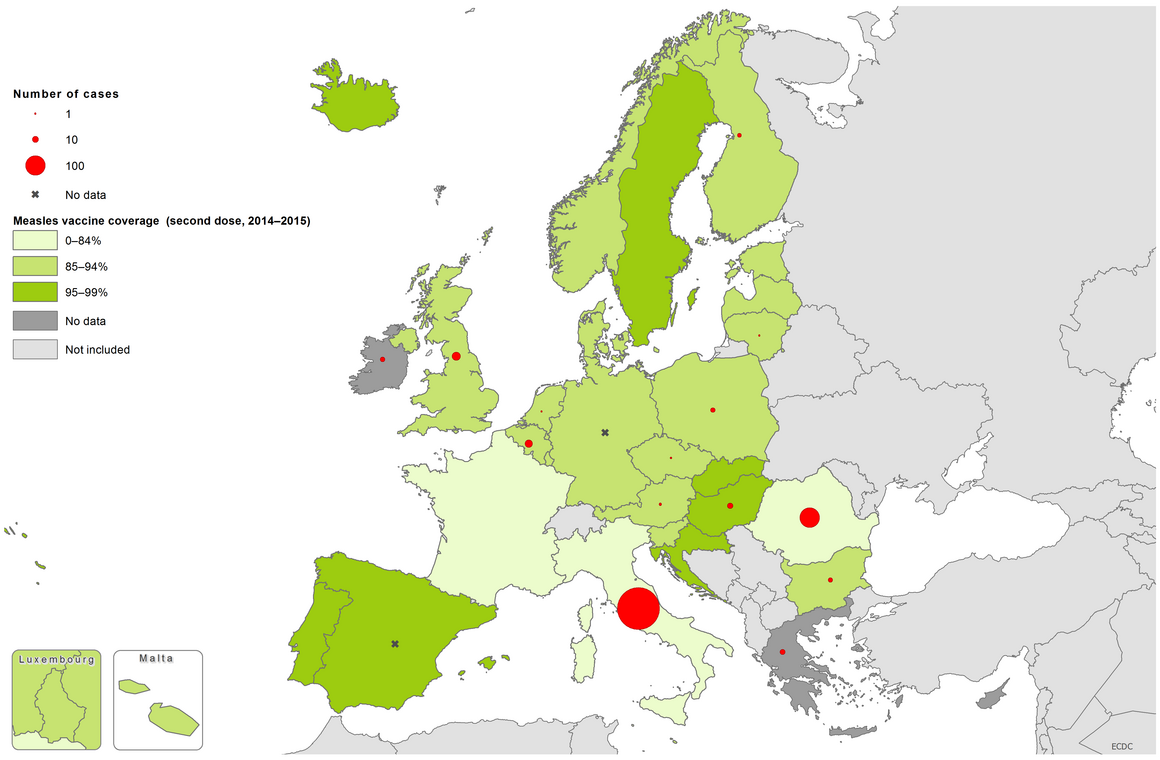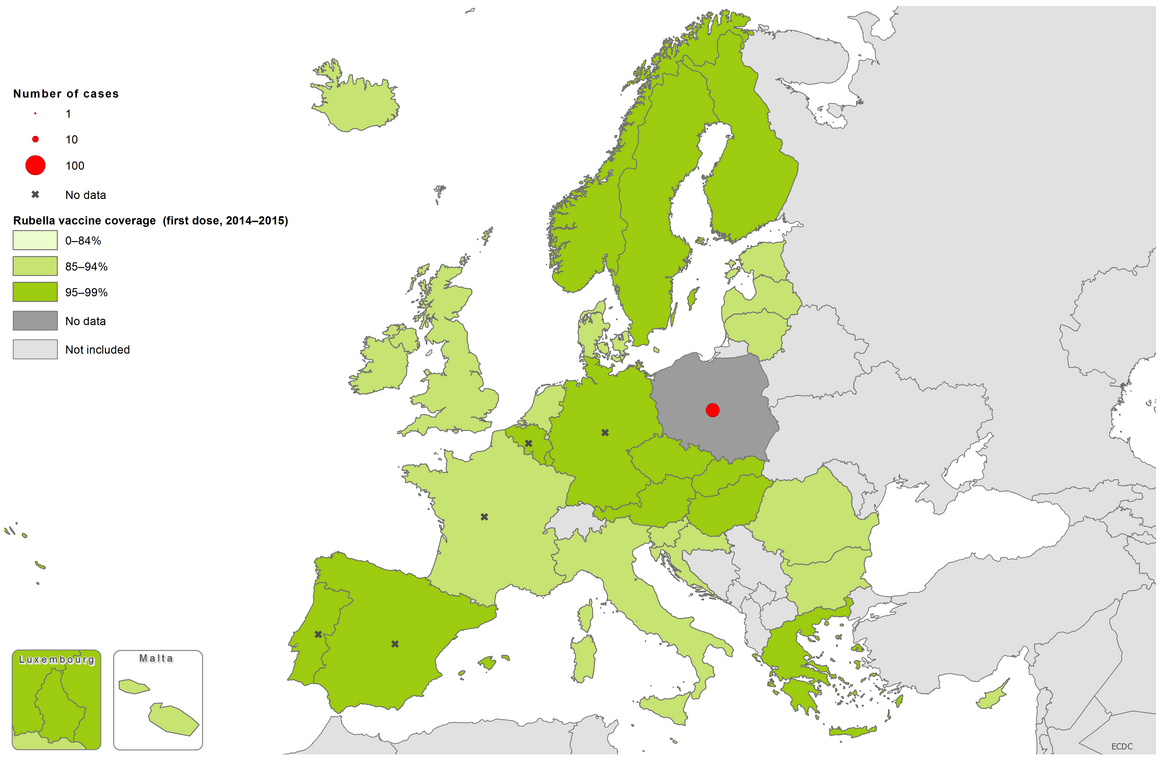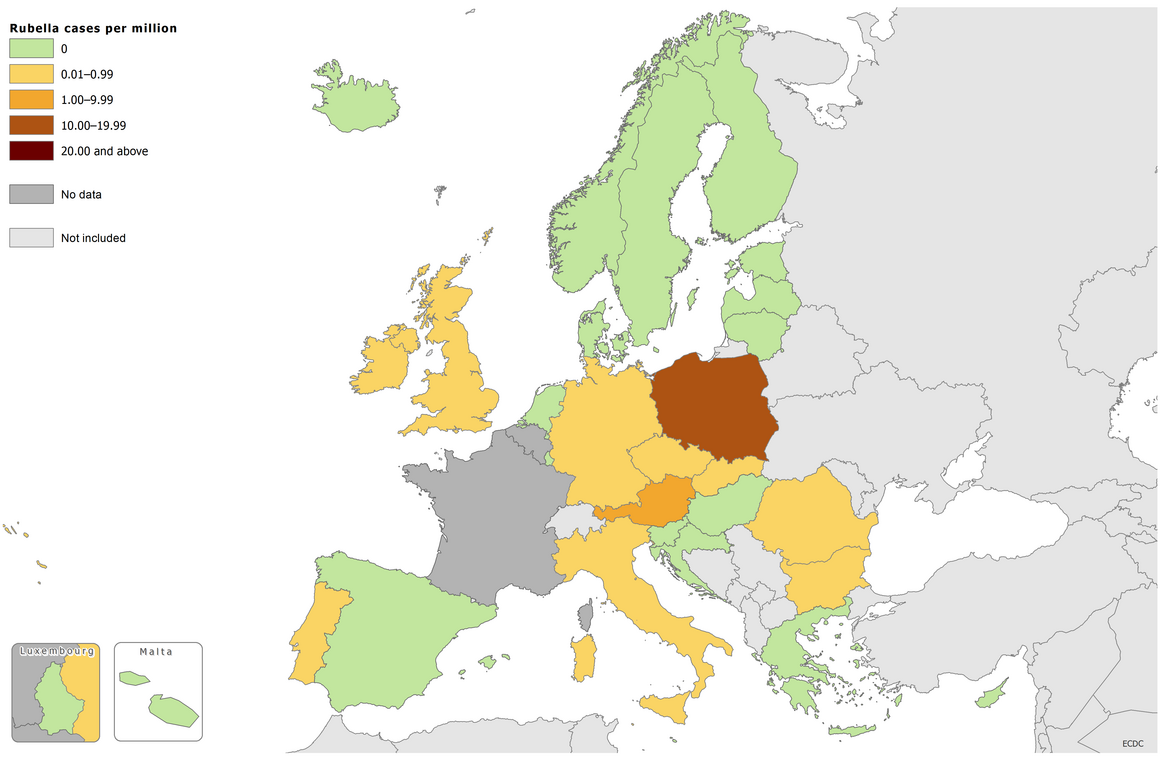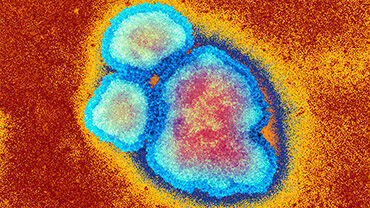Monthly measles and rubella monitoring report, August, 2017
ECDC publishes a monthly surveillance report on measles and rubella data submitted by the 30 EU/EEA countries. ECDC also monitors European and worldwide measles outbreaks through epidemic intelligence and reports on them on a monthly basis in the Communicable Disease Threat Reports.
Executive Summary
Measles
From 1 January 2016 to end July 2017, more than 17 000 measles cases were reported, with 40 deaths attributed to measles (source: TESSy and Epidemic Intelligence at ECDC).
In the first seven months of 2017, a total of 9 642 cases were reported. This is over five times more than in the same months of 2016, when 1 849 cases had been reported. The countries contributing to the majority of cases were Italy (4 204), Romania (3 117) and Germany (798).
In the 12-month period between 1 August, 2016, and 31 July 2017, 30 EU/EEA Member States reported 12 439 cases of measles. Twenty-eight Member States reported consistently throughout the 12-month period. Germany and Spain did not report data for July 2017.
The highest number of cases was reported by Romania (5 067), Italy (4 544) and Germany (915), accounting for 41%, 37% and 7% respectively of the EU/EEA cases. The diagnosis of measles was confirmed by positive laboratory results (serology, virus detection or isolation) in 62% of all EU/EEA cases.
Over the 12 months’ period, the measles notification rate was below one case per million population in 7 of the 30 reporting countries. Three of these Member States reported zero cases. The highest notification rates were observed in Romania (256.4 per million), Italy (74.9 per million) and Belgium (32.5 per million).
Of all cases with known age (n=12437), 4 580 (37%) were children less than 5 years of age, while 5 616 (45%) were aged 15 years or older. The highest incidence was reported in children below one year of age (299 per million) and children from 1 to 4 years of age (144 per million).
Measles continues to spread across Europe because the vaccination coverage in many EU/EEA countries is suboptimal. The latest available figures on vaccination coverage collected by WHO (2016) show that the vaccination coverage for the second dose of measles was below 95% in 20 of 27 EU/EEA countries reporting second dose coverage data. The vaccination coverage for the first dose of measles was below 95% in 18 of 30 EU/EEA countries. If the elimination goal is to be reached, the vaccination coverage rates for children targeted by routine vaccination programmes should increase in a number of countries as the vaccination coverage of the second dose must be at least 95% to interrupt measles circulation.
Of all cases with known vaccination status (11 688), 87% were unvaccinated, 8% were vaccinated with one dose, 3% were vaccinated with two or more doses, and 2% were vaccinated with an unknown number of doses. Of all cases, 6% had an unknown vaccination status.
The proportion of cases with unknown vaccination status was highest in adults aged 25-29 year-old and 30 years and over, reaching 13% and 11% respectively in these two age groups. The proportion of unvaccinated cases was highest among children below one year of age (96%). This was expected as these children are too young to have received the first dose of measles vaccine. Infants below the age of one year are particularly vulnerable to complications of measles and are best protected by herd immunity, which is achieved when population coverage for the second dose of a measles-containing vaccine is at least 95%.
In the target group for the first dose of routine childhood MMR vaccination (1-4 year-old), 86% of the cases were unvaccinated, 12% were vaccinated with one dose, 0% with two doses or more, 0% with an unknown number of doses and 2% had an unknown vaccination status.
Twenty-five deaths due to measles were reported during the 12-month period; with 18 in Romania, three in Italy, and one in Bulgaria, Germany, Spain and Portugal.
For Romania, the number of measles cases reported to ECDC is different from the number regularly published by the National Institute of Public Health in Romania due to the delay in case-based reporting to ECDC. ECDC has published a Rapid Risk Assessment on the current outbreak in Romania.
Measles outbreaks are also ongoing in other EU countries. All EU/EEA countries have reported measles cases this year, except for Latvia, Liechtenstein, Malta and Norway. See more information in the latest CDTR.
Rubella
Between 1 August 2016 and 31 July 2017, 28 EU/EEA Member States reported 803 cases of rubella. Belgium and France did not report. Of the 28 reporting Member States, 25 reported rubella cases to ECDC consistently throughout the 12-month period. Germany and Spain did not report in July 2017 and Portugal not in May to July.
Rubella is targeted for elimination in Europe. The rubella notification rate was lower than the elimination target (one case per million population) in 26 of the 28 countries. Seventeen of these 26 countries reported zero cases. The highest reporting rate was by Poland (16.6 cases per million population) and Austria (3.1 cases per million population).
Poland accounted for 78% of all rubella cases in the period (n=629). Data from Poland were reported in an aggregated format and need to be interpreted with caution, as only 8 cases were confirmed through laboratory testing. The highest number of cases in Poland was observed in children, with 47% of cases less than 5 years of age and 26% aged from five to nine years of age.
ECDC monitors European rubella outbreaks on a monthly basis through Epidemic Intelligence. No new rubella outbreaks were detected by Epidemic Intelligence in the EU/EEA since the last monthly update. See more information in the CDTR.
Figure and tables










